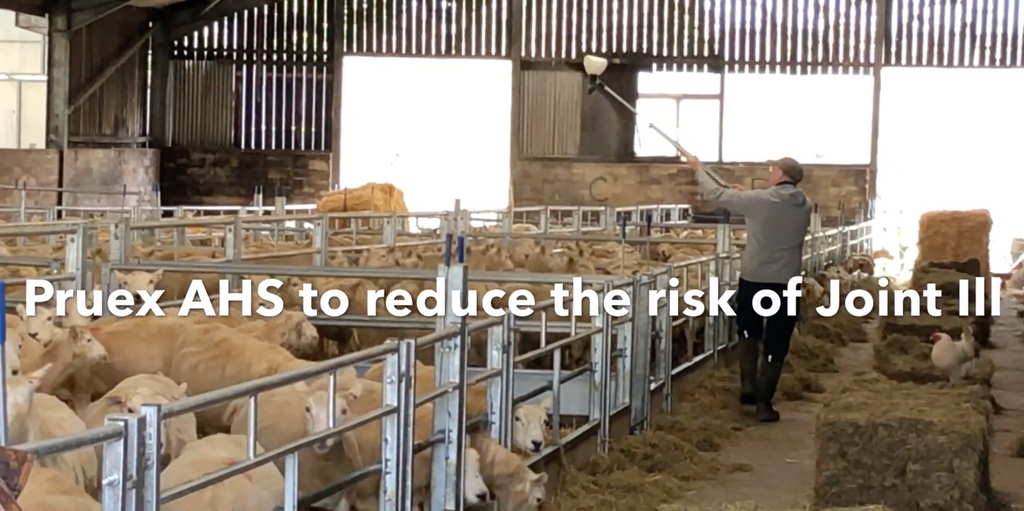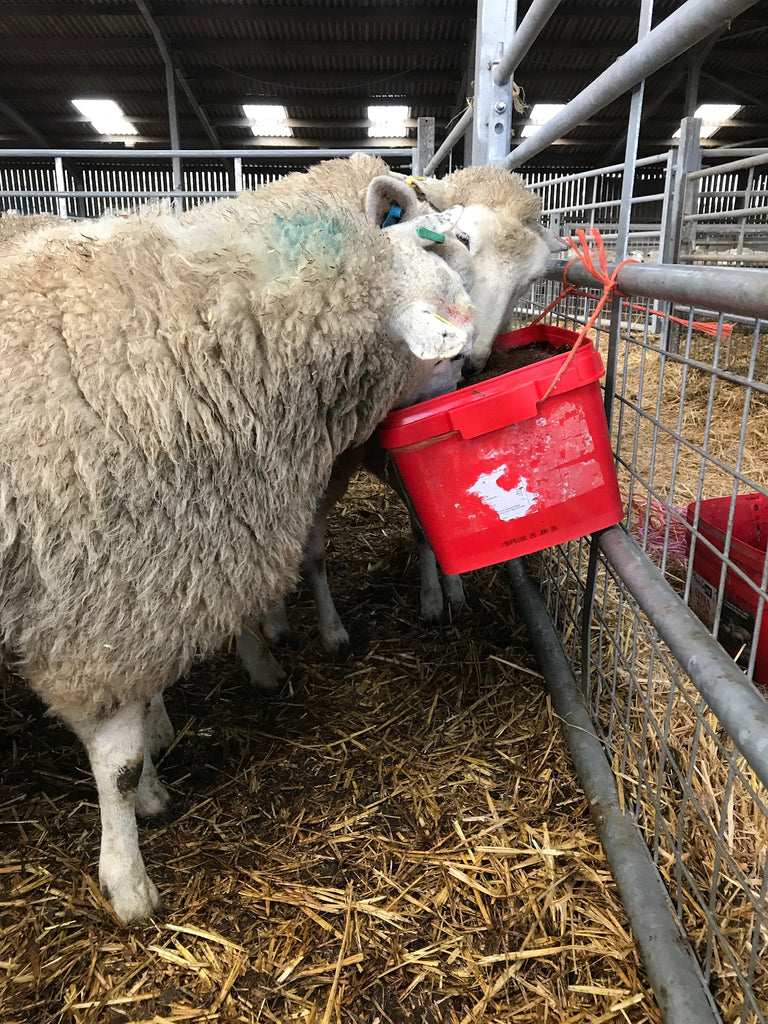News / Watery Mouth
Pruex 5 point plan. £3000 annual reduction in antibiotic bill.
The Perkins family farm at Dinas Island in West Wales and are one of the main ram producer farms for Innovis, with 500 Abermax stock ewes and a 1,000 strong Lleyn flock with 500 in the Aberfield SR program and 500 put to a Lleyn ram for pure breeding.

The ewes are housed in December for March lambing due to the harsh weather conditions confounded on Dinas Island by a lack of shelter, and are turned out following the recording of ewe and lamb data, such as ease of lambing and birth weights. Prior to implementing the Pruex 5 Point Plan the farm were using lime with straw bedding in an attempt to limit various health issues including joint ill. Pregnant ewes were moved out of their pens weekly and run through an external footbath in an attempt to combat lameness. The worst ewes being targeted and segregated for individual antibiotics treatment. Maintaining clean and dry bedding was a constant battle. Detailed record keeping highlighted the costs of culling heavily according to foot health. Repeat offending ewes with foot problems were culled from the flock increasing the number of ewe lamb replacements needed. Neil noted that prior to using the Pruex products the farm records magnified that foot treatments were the main health burden and were utilising a significant amount of time, resources and money.
Since using Pruex in the lambing shed and in the water supply from December 2018 onwards, the family have stopped using lime as well as foot bathing completely and have seen significant reductions in lameness and lamb infections such as joint ill which used to occur in 2 to 3% of lambs. Pruex Stabiliser is applied as a mist directly onto the bedding in the ewes pens as well as the individual mothering pens daily. Neil has made some rough calculations himself and believes that by drying up the bedding with the mist of Pruex Stabiliser the savings in straw alone equate to the cost of the Pruex products, and that other health benefits such as reduced lameness and lamb infections such as joint ill are a bonus. His antibiotic bill has reduced by £3,000 annually, a major objective of his flock health plan. “The sheep sector is a low net user of antibiotics when compared to other meat sectors, but do use heavily during the lambing period. It’s been the focus of our work for this sector at Pruex, and this type of reduction shows what can be achieved in a small amount of time when farmers have the determination and focus portrayed by the Perkins family”, said Aled Davies,
founder of the company.
Water treatment is done via a dosatron pump with the whole farm receiving treatment 365 days of the year. This incorporates into the rotational grazing program utilised with each water trough readily treated. The water troughs are routinely cleaned before fresh break moves and given an extra 300ml shock treatment of Pruex Water Plus plus as the trough refills.
The detailed record keeping of foot treatments continues and in 2019 the total treatments on the farm have dropped by 68% and the total for 2020 in on track to mirror that improvement. This not only saves time and labour, but it has also reduced the culling rate on the farm due to a reduction in repeat offenders. The farm have also noted a significant reduction in joint ill cases which were
previously treated by catching lambs outdoors, with
problem cases injected with antibiotics. Since the 2019 lambing the number of joint ill cases have reduced greatly with only 3 lambs needing treatment annually.
The plan of action for the 2021 lambing season is to build on the knowledge gained over the last two lambing seasons. In addition to misting the bedding with Pruex Stabiliser and treating the water with Pruex Water Plus, and in order to reduce both workload and toxic bacterial loading on newborn lambs, Pruex Base Layer will be used instead of lime and straw in the mothering pens.
Pruex Base Layer is dust extracted chopped straw (2cm), treated at bagging with Pruex bacteria. It will be used in conjunction with Pruex Stabiliser to absorb moisture and populate good bacteria in the area where lambs need protection during the early stages of their lives.

Pruex 5 Point Plan - Watery Mouth & Joint Ill
Sheep sheds often start off as dry and relatively clean areas for sheep housing, but as time passes, moisture, faeces, body fluids and other animal contamination, (including bacteria and protozoa), raise to a level which can cause issues for sheep and lamb health.
Pruex have learned a great deal over the last three lambing seasons and have developed a simple 5 point plan that attempts to help shepherds reduce the risk of watery mouth and joint Ill.
Within the plan, farmers will need misting equipment to apply Animal House Stabiliser (AHS Green Top), to bedding and Water Plus (Blue Top) to water. These products can be viewed or purchased from the buttons below.
Managing reductions in the risk of Joint Ill and Watery Mouth
Two years ago Mathew Isaac started using the Pruex protocol to try and reduce 'Joint Ill and Watery Mouth'........How did they achieve this???
As a result Joint Ill was not a problem for young lambs. This significantly reduced the use of antibiotics within the flock from an already low level.
They have repeated the Pruex protocol this year and are spraying the bedding with AHS daily and using the Water Plus to treat the water. This year Mathew has seen a significant reduction in antibiotic use and no 'Joint Ill'.
Samples taken, as illustrated above, show a single E.coli colony (bright pink), within the bedding, probably originating from ewe faeces, and no e.coli growing on the ewes face. The plate labelled 'Land drain Water' shows both good bacteria and bad bacteria, the purple e.coli and the turquoise streps obviously coming from sheep droppings within the water pipes. These droppings are removed daily and there is a commitment to raising the level at which the pipes are situated to prevent this problem.
Watery mouth and Joint Ill can be the result of bacterial contaminations within water and bedding. Pruex work with farmers to reduce the risk of infection from disease causing bacteria, therefore, reducing the need for antibiotic treatment.
Mathew hasn't had watery mouth or Joint Ill as a result of his good management and Pruex protocols (apart from one lamb that failed to receive colostrum. Over a thousand ewes lambed).
Reducing the risk of Watery Mouth and Joint Ill
Shepherds have often wondered why typically only one lamb from twins gets watery mouth. Work done by Pruex has identified biofilm on the ewes face as being problematic for the first lamb born. E.Coli from the ewes face being transferred to the lambs mouth during the process of the ewe licking dry the lamb. The second lamb born typically doesn’t receive as much attention as the first as the ewe has to protect/care for the first born whilst it finds it’s feet. The first born will attempt to suck the ewes face as she licks it. The second lamb has less opportunity to infect its digestive system with E.Coli from the ewes face.
Pruex have devised a 5 point plan to help reduce the risk of lambs getting watery mouth. It’s featured in the video below.
Finding a cause of watery mouth – an observation with big consequences for antibiotic use in the sheep sector.
Overbury Enterprises in Gloucestershire is in the middle of their laming season this year. In previous years, watery mouth in lambs, a disease caused by the poisonous toxins generated as E.Coli bacteria replicate within newborn lambs, has required the use of antibiotics at birth. The team were already trying to reduce reliance of anitibiotic use. Jake freestone, the Farm Manager states that "Previously we held off oral antibiotic use at the start of lambing and started using it when we got the first few cases of watery mouth".This year, Jake, along with the estate shepherd, Rheinallt Arch and his team have worked with Pruex to try to limit the potential risk of E.Coli infections in newborn lambs. As a result, an observation made could have benefits for all sheep producers.
Bacterial swabs taken ahead of sheep housing highlighted potentially harmful colonies of bacteria, including E.Coli within biofilms in the water system, and the surfaces of the sheep sheds. As a result, Pruex recommended a probiotic cleaning process to limit the risk of infection from these antagonists.
The water system is supplemented with “Water Plus”, a probiotic, which cleans out the biofilm layers within the water pipes and troughs. Sheep bedding is kept dry by applying a fine mist of “AHS”, a probiotic at least twice a week, or daily if conditions are wet.
Video showing clean water and clean water trough
Swabs taken at regular intervals throughout the sheep housing period have demonstrated the dominance of the probiotic bacteria applied. The latest tests, taken half way through the lambing season found no E.Coli colonies in bedding where lambs are born, nor water samples.
However, watery mouth has been witnessed again this year, which could typically only happen if E.coli bacteria are present and infect newborn lambs. What is strange is that it would affect one lamb from a pair of twins. Colostrum management at the farm is well managed, the ewes condition is modulated by management of variables such as feed and stocking rate.

Aled Davies of Pruex was determined to find the source of E.Coli infections, because the usual suspects of water and bedding were obviously not the source of infection. He observed that all free access mineral buckets within the sheep pens were contaminated by sheep droppings. E.Coli bacteria from the droppings, sugar from the molasses in the mineral product, moisture and a far warmer shed temperature would make a fantastic breeding ground for the E.Coli to multiply. Once the buckets were removed from the sheep pens, the watery mouth stopped within two days.

So, how does sheep droppings in a molasses based mineral bucket result in watery mouth in one twin lamb and not the other? Aled Davies has a theory, which, if proved, could have great implications for the sheep industry, reducing use of antibiotics, stress on animals and shepherds, and slowing down the rate of antimicrobial resistance to antibiotics. Aled thinks that the ewe, whilst eating the mineral, gets a mixture of sugar and E.Coli on its mouth. A nice warm environment, the bacteria would have heat, a source of mineral, energy in the form of carbohydrate and moisture from the ewe drinking water. These elements are all that is needed for a nasty biofilm to develop on the ewes face. Once the first lamb is born, the ewe licks the lamb, and will often lick the lambs' mouth. The E.Coli bacteria on its face being transferred into the newborn lambs’ digestive system. The dilution affect of licking the first lamb could remove or dilute the E.Coli on the ewe’s face so that the second lamb doesn’t get the infection via its mouth. Also, the second lamb tends to get less maternal licking as the ewe has to attend to the first born lamb as well. Lambing outside, the ewes’ face would be covered in soil bacteria, non infective, and not dominant in fecal bugs such as E.Coli.
Calling all shepherds. Do you agree with this theory? Aled Davies would like to hear from you. aled@pruex.co.uk
Calling all research institutes. Would you like to research this further and prove or disprove the theory? The whole industry would benefit if you did.
Calling all levy boards. Can you get involved in researching this theory?
This video was posted on Facebook. It shows a thoroughly licked first born lamb, and a second lamb still covered in birth fluid. The mouth of the first lamb born has obviously been licked by the ewe.








